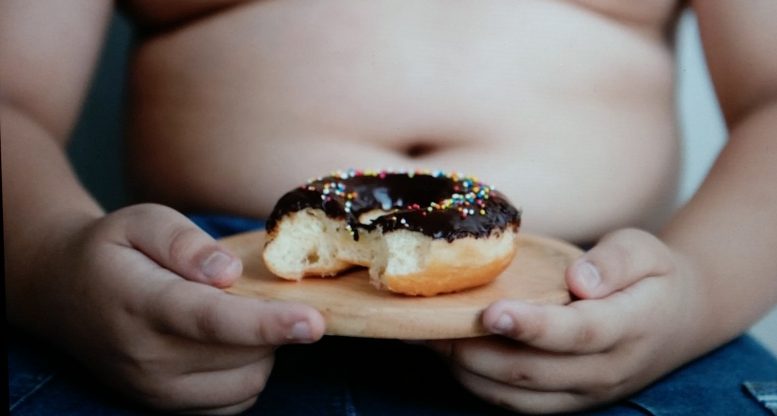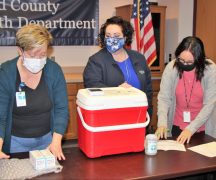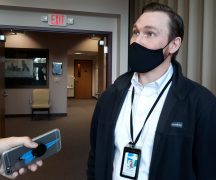By JAN LARSON McLAUGHLIN
BG Independent News
When Diane Krill was a child, she spent summer days playing in the park – not parked in front of the TV.
“We were there from sun up to sundown,” she said of days of non-stop activity. “We didn’t go home until the dinner bell rang.”
But times are different now, said Krill, CEO of the Wood County Community Health Center. Parents afraid to let their children roam the neighborhood sometimes prefer to use the TV as a babysitter. And when they do activities – like soccer or baseball – busy parents often rush through a fast food drive thru to pick up dinner.
“We are seeing trends that are leading from childhood to adulthood,” said Wood County Health Commissioner Ben Batey. The likelihood that an obese child will learn healthy eating and exercise habits as an adult is, well, slim.
So on Tuesday, the Wood County Health Department held a meeting on childhood obesity for interested community members. A recently conducted Community Health Assessment showed that 72 percent of Wood County adults are overweight or obese – higher than the state average of 67 percent.
That adds up to about 37,000 Wood County adults who can be labeled as obese.
“That seems staggering,” Batey said. “What can we do about that?”
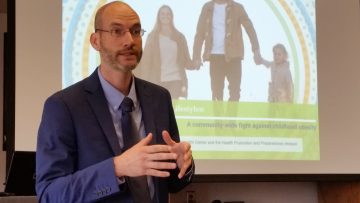
Wood County Health Commissioner Ben Batey talks about childhood obesity.
The survey found slightly better results among local youth, where the number of obese youth dropped a bit in the last three years.
“We’re seeing a positive trend with our youth, and we don’t want to lose that,” he said.
A big problem appears to be that many Wood County adults are not modeling healthy exercise or eating habits for their children. And discussing people’s diets can be a potential minefield – like bringing up politics or religion, Batey said.
When surveyed about exercise, many local adults said they don’t have time for physical activity. However, in the same survey, adults averaged 2.4 hours a day watching TV, 1.5 hours on their cell phones, and 1.4 hours on the computer for non-work items.
“We’re not taking time to get up and move,” Batey said. “I’m not saying don’t watch TV. But get up and move while you’re watching TV.”
Batey admitted to being a “couch potato” himself, and eating too much fast food – until he and his wife had their first child.
“This is about childhood obesity. But kids learn from our behaviors as adults,” he said.
In the countywide health survey, 76 percent of the parents said the most physical activity they participate in with their children is cleaning and yardwork. While that’s all good, it’s not showing kids that exercise can be fun.
“Are we setting the standard that kids want to get physical activity,” Batey said. “What messages are we sending to our kids?”
Batey’s household has a rule that each family member must be in some structured physical activity that they enjoy – so there is a commitment. “It becomes important that we make time,” he said.
Otherwise, exercise is often the first item to be cut from daily schedules.
“The majority of people, we’re just not wired that way,” Batey said of exercising when a comfy couch is the other option. “We’re wired for comfort.”
But even for a public health professional, it can be tough. Introducing kale into the Batey family diet was a less than popular decision. And it’s tempting at times to just turn on Netflix and let the kids gorge themselves on TV. It’s an “easy default” for parents who have work to get done, Batey said.
Snacks can be another culprit – since they now make up about 27 percent of an average child’s total daily calories, according to Katie Barricklow, nurse practitioner at the Wood County Community Health Center.
“You want to emphasize fruits and vegetables,” Barricklow said.
However, the vast majority of easy “finger foods” in grocery stores are not exactly healthy. And healthy food, like produce, takes time to clean and cut up.
“Most parents gravitate toward pre-packaged snacks that are easy,” she said.
And kids tend to prefer unhealthy snack selections – attributing to Frito Lay having the top sales of all snack food companies, Barricklow said.
“You can’t really blame kids,” she said, showing photos from local grocery stores of all the brightly packaged snacks on lower shelves within reach of little hands.
Schools may also need to examine their menu options, she said. The ala carte menu at Bowling Green City Schools’ cafeterias include healthy choices like raisins, yogurt, string cheese and fresh fruit. But they also offer chips, ice cream, breadsticks, French fries, and Pop Tarts.
In defense of schools, Barricklow said school cafeterias are poorly funded. “They have to sell things kids are going to buy,” she said.
Barricklow recommended parents keep a range of healthy snacks at home. She stressed that “parents provide, kids decide.”
“Remember, you’re in control. The kinds of foods they are given is what they will have to eat,” she said.
Barricklow offered the following tips for parents:
- Avoid processed foods sold in bags and boxes, with added sugars.
- Teach kids to eat a rainbow of colors in fruits and vegetables.
- Save time by slicing produce ahead of time.
- Encourage kids to drink milk. “A lot of time we mistake thirst for hunger,” she said.
- A true snack should be no more than 150 calories. “Keep an eye on the size.”
- Don’t fall for snacks labeled as being “healthy.” Check the nutrition label.
- Swap out sugary drinks, by mixing seltzer water with 100 percent juice.
- Involve kids in preparing their own snacks.
- Go online and check out healthy snack ideas.
“We can’t expect children to make rational choices unless we educate them,” Barricklow said. And that means parents need to set good examples.
“Be a good role model. Don’t give your kid a banana, then get a bag of Doritos out for yourself,” she said.
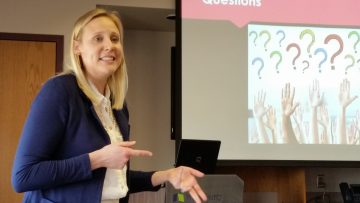
Pediatrician Melissa Moore
Dr. Melissa Moore, a pediatrician, said nearly one in five school-age children are obese. The long-term effects can include heart disease, diabetes, arthritis, and possible acceleration of cancer.
The short-term effects of childhood obesity include negative psychological impacts, sleep apnea that can cause behavioral or learning problems, bone issues, high cholesterol, high blood pressure, early puberty and early periods.
Moore said the youngest patient she has treated for Type 2 Diabetes was 8 years old.
The psychological effects are also damaging, with obese children being the target of bullying and social isolation. She spoke of girls breaking down crying during their doctor’s appointments.
“Kids are mean. They are super mean,” Moore said.
Obese kids often suffer from depression and develop eating disorders. The dopamine from sweets can lead to kids binging on food – which then becomes a vicious cycle.
Also during Tuesday’s meeting, Fran Leass, a behavioral health specialist with the Wood County Community Health Center, talked about some youth using food to soothe anxiety and depression. Those sexually abused as children sometimes overeat to create a shield, she said.
“A lot of what’s happening in adolescents is what we’re treating at 50 years old,” Leass said.
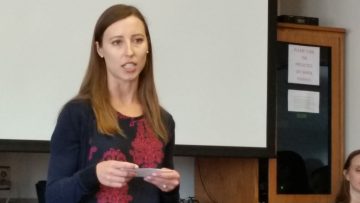
Nutritionist Lauren Snyder
Lauren Snyder, a nutritionist at the Wood County Health Department, talked about the link between weight gain during pregnancy and childhood obesity. She also shared data on how a baby’s first nutrition can decrease the risk of early obesity.
“Just by breastfeeding for nine months you can reduce your child’s chance of obesity by 36 percent,” Snyder said.
Batey suggested that quarterly meetings be held to continue the childhood obesity conversation with community partners.
“We’re looking for help from the community,” he said.

